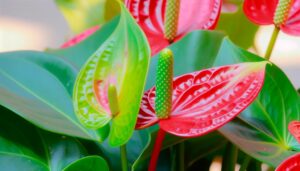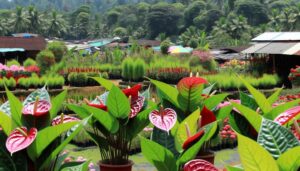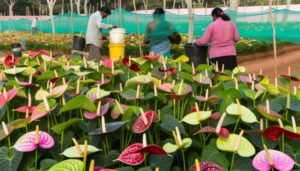5 Tips for Thriving Plants When Anthurium Is Planted Outside
For thriving outdoor anthuriums, start by choosing a spot with morning sun and afternoon shade. Confirm the soil is well-draining, slightly acidic (pH 5.5-6.5), and enriched with organic matter.
Water in the morning and use mulch to retain moisture, adjusting frequency based on weather. Provide 8-10 hours of indirect light, avoiding direct sunlight to prevent leaf scorch.
Regularly check for pests like aphids and spider mites, using natural predators and organic treatments. By following these tips, you’ll create ideal conditions for your anthurium to flourish.
Let’s explore more to perfect your plant care strategy.
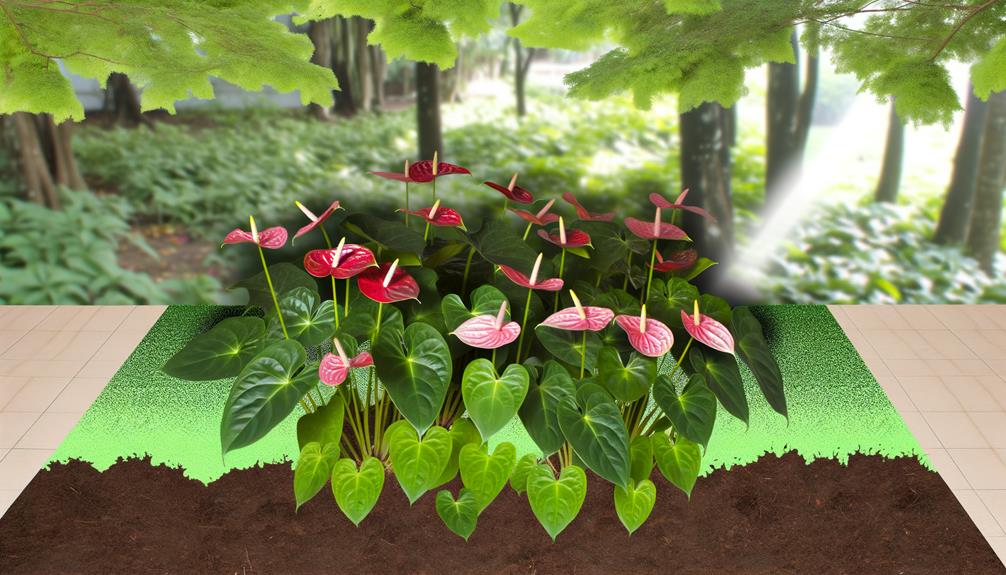
Key Takeaways
- Choose a location with dappled sunlight and ensure morning sun with afternoon shade.
- Ensure soil is well-draining and has a pH between 5.5 and 6.5.
- Water in the morning, checking soil moisture regularly, and use mulch to retain moisture.
- Provide 8-10 hours of indirect light daily, avoiding direct sunlight to prevent leaf scorching.
- Monitor for pests weekly, using natural predators and organic solutions like neem oil.
1. Choose the Right Location
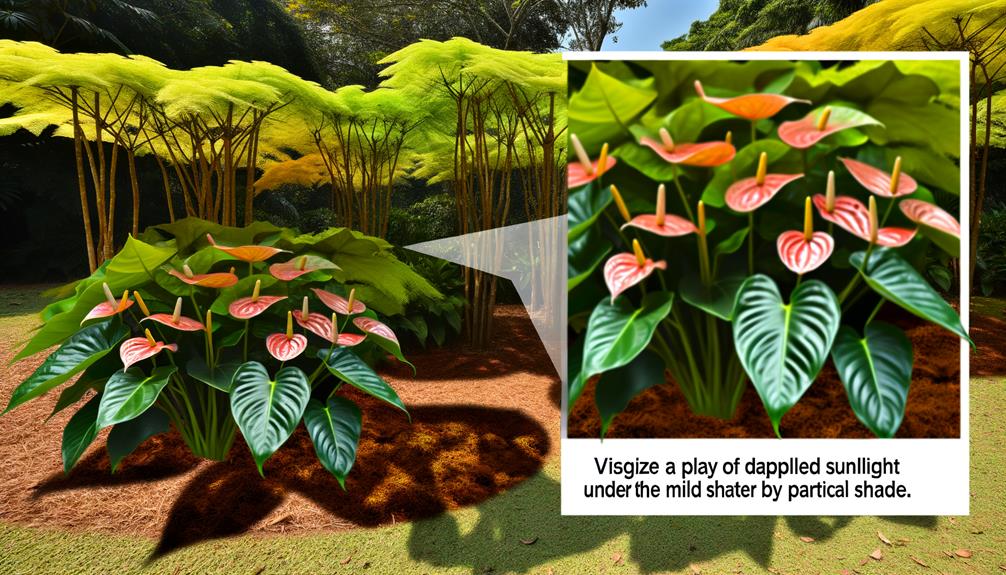
Selecting the best location for your outdoor anthurium involves considering factors like sunlight exposure, soil quality, and humidity levels.
You’ll want to find a spot where the plant gets dappled sunlight; direct sun can scorch the leaves, while too much shade might stunt its growth. A location with morning sun and afternoon shade is ideal.
Next, focus on soil drainage. Anthuriums thrive in well-draining soil to prevent root rot. Check if water drains quickly through the soil. If it puddles, the spot isn’t suitable.
Additionally, choose an area with high humidity, as anthuriums flourish in moist environments. By prioritizing proper sun exposure and soil drainage, you’ll set the stage for your anthurium to thrive outdoors.
2. Prepare the Soil
To prepare the soil for your outdoor anthurium, start by ensuring it’s rich in organic matter and has excellent drainage capabilities. Begin with soil testing to determine its pH and nutrient levels.
Anthuriums thrive in slightly acidic to neutral soils, with a pH between 5.5 and 6.5. Once you’ve tested the soil, incorporate organic amendments like compost, aged manure, or peat moss to boost its fertility and structure.
These amendments improve water retention without compromising drainage. Mix the organic matter thoroughly into the top 6-8 inches of soil.
Additionally, consider adding perlite or coarse sand to enhance aeration and drainage further. By taking these steps, you’ll create an ideal environment for your anthurium to flourish outdoors.
3. Watering Needs

Ensuring your outdoor anthurium receives consistent and appropriate watering is vital for its health and growth.
Proper drainage is essential to prevent waterlogging, which can lead to root rot. Maintain soil moisture by checking the soil regularly and watering when the top inch feels dry.
Here are some practical tips:
- Check soil moisture: Use your finger or a moisture meter.
- Water early: Morning watering reduces evaporation and fungal risks.
- Avoid waterlogging: Make sure pots have drainage holes or create a well-draining garden bed.
- Mulch: Apply a layer of organic mulch to retain soil moisture and regulate temperature.
- Adjust for weather: Increase watering in hot, dry periods; decrease during rainy seasons.
4. Provide Adequate Light
Although anthuriums thrive in bright, indirect light, exposing them to direct sunlight can scorch their leaves and hinder their growth. You should aim to provide filtered light by placing your plants under the canopy of larger trees or using shade cloths.
The light duration is vital; around 8-10 hours of indirect light daily is best. Pay attention to sunlight intensity, as too much can cause leaf burn, while too little can stunt growth.
If you notice the leaves turning yellow, it might indicate excessive sunlight. Conversely, dark green leaves suggest insufficient light.
Monitoring these factors will guarantee your anthuriums receive the precise amount of light they need without the risk of damage from harsh sunlight.
5. Protect From Pests

Monitoring your anthuriums regularly for pests like aphids, mealybugs, and spider mites is essential to maintaining their health when planted outside. These pests can cause significant damage by sucking the sap and weakening the plants.
Introduce natural predators like ladybugs and predatory mites to keep pest populations under control. Utilize organic solutions such as neem oil or insecticidal soap for effective, eco-friendly pest management.
Here are some practical steps:
- Inspect the leaves and stems weekly for signs of pests.
- Remove any visible pests by hand or with a water spray.
- Apply neem oil bi-weekly to prevent infestations.
- Encourage birds in your garden, as they feed on pests.
- Maintain plant health through proper watering and nutrition.
Conclusion
To sum up, by selecting the right location, meticulously preparing the soil, meeting watering needs, ensuring ample light, and protecting from pests, your outdoor anthurium can thrive.
Think of your plant as a delicate dancer; it requires the perfect stage, spotlight, and care to perform beautifully.
Remember, attention to detail and consistent care are key.
With these steps, your anthurium won’t just survive but flourish, adding a vibrant touch to your garden.

